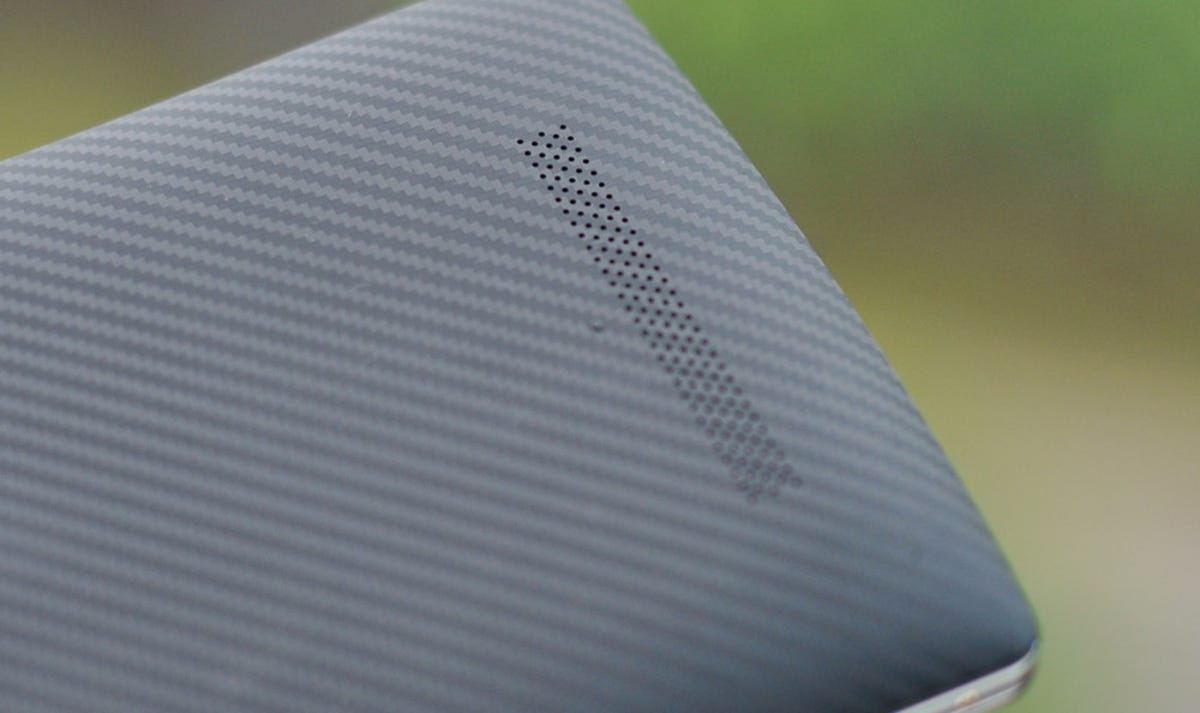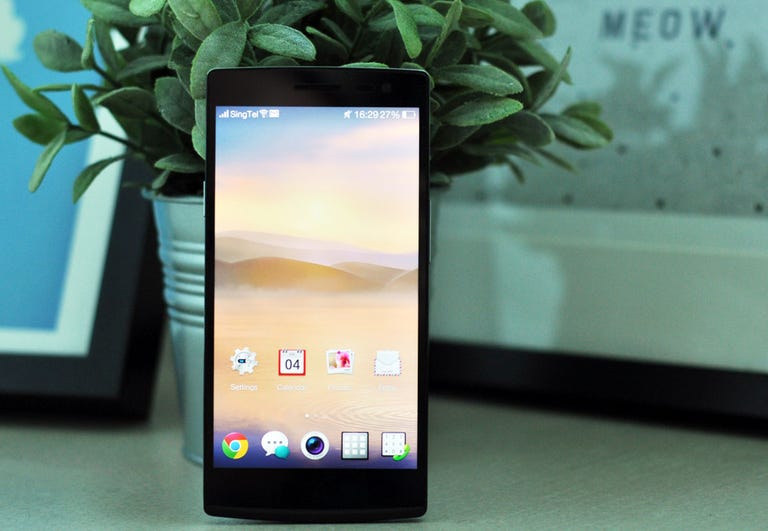 Why You Can Trust CNET
Why You Can Trust CNET Oppo Find 7 review: A terrific screen and cool features, but still falls short
Oppo's Find 7 may have impressive specs such as a quad-core chip and a very high-resolution screen, but it doesn't get the blood racing like some of its competition.
The Oppo Find 7, like the OnePlus One , is a Chinese-made phone with plenty of promise, but it comes with a much higher price tag: $599, (£350 or AU$640).
The Good
The Bad
The Bottom Line
As Chinese phones generally are known for their low cost, the Oppo Find 7 is expensive when compared with its domestic rivals. On one hand, given that it's the only handset available globally that has a high-resolution 5.5-inch 2,560x1,440-pixel display other than the LG G3 ($690, £490, or AU$799 without a contract), the premium can somewhat be justified. Yet, it's still quite a hefty price for a display that you may not really need and features that don't stand out from the competition. And it doesn't help that for just a dollar more, you can get the Samsung Galaxy S5 .
The Find 7 is available to preorder in the UK from Oppo's European store, where it's priced at €479 SIM-free, which converts to £380. It'll ship in early July. You can also buy it now in Singapore. US and Australian availability has yet to be announced.
Design and specs
The Find 7 might remind you of the OnePlus One, if you've been following my recent reviews. The two phones are made in the same factory and likely share the same mould. The shape and size are similar, but the placement of buttons differs. The Find 7's speakers are on the back instead of at the bottom, and the camera is a little lower down the back.

I do, however, like the feel of the Find 7 a little better. The textured plastic rear has more grip, and the metallic bandings around the edges give the phone a touch of class.
The 5.5-inch "Quad HD" display -- that's 2,560x1,440 pixels, the same as four 720p screens -- is bright and brilliant, and usable even under bright sunlight. It crams in 538 pixels per inch -- far, far more than Apple's "Retina" displays. That said, the display doesn't appear any any sharper than a normal 1080p screen of similar size.
Like the OnePlus One, I found the phone a little too large to use comfortably, and I'm guessing most of you will have to use both thumbs to type properly. This is usually the case with phones that have screens larger than 5 inches.
While the Find 7 is larger than the G3, it's actually only a little bit wider. But I did feel that typing on the G3 with one thumb was a lot easier, so that extra space does make a difference.
Three touch-sensitive buttons are located below the screen, and the phone uses the old-style Android menu button instead of the multitasking button. While these keys are backlit, they are pretty dim, and you won't be able to make them out in bright light. It also appears you can't switch to use onscreen keys unlike the OnePlus One, so you're stuck with the back button located on the right side.
I mostly use phones in my left hand, so it's quite annoying to stretch out my thumb to hit the back button, only to find that the fleshy bit of my palm has accidentally hit the menu button. It would have been nice if the phone had onscreen keys or the ability to customise where the back button is.
Internally, the Find 7 is powered by a 2.5GHz Qualcomm Snapdragon 801 processor, 3GB of RAM, and 32GB of onboard storage. There's also a microSD card slot located underneath the cover, but you'll have to take out the battery to swap cards.
Connectivity-wise, it has 4G LTE support, and there are two variants: the international model should work for most countries in Europe and around the world, while the US and Mexico version comes with frequencies tuned for these markets.
Besides LTE, the Find 7 also has quad-band 3G support, which should work on most networks around the world, and the usual NFC, Bluetooth, and Wi-Fi.
Software and features
If you've read my Oppo N1 review , you'll be familiar with the Color OS that the Find 7 uses, a skin that runs over Android 4.3 Jelly Bean. It comes with a few innovative software features that you don't really see in other phones.
For one, the phone has a gesture panel that can be turned on by sliding down from the top left side. Once there, you can draw with your finger to quickly activate apps. The default gestures allow you to draw a circle to open the camera, or a V to turn on the flashlight, for example. You can add your own -- for example, a W to open WhatsApp messenger.
Gestures also work when the screen is off -- you can slide two fingers down to play a song, draw an arrow to skip or rewind tracks. You can also double-tap the screen when it's off to wake the phone, similar to the LG G3 and the OnePlus One. (Color OS has a proximity feature that detects when the phone is in your pocket and prevents it from accidentally activating.) I like this a lot, since I had plenty of issues with the One and the G3 accidentally turning on due to a very thin material lining my pockets.
Oppo has also added Swype keyboard as the default input option, but you can swap it out for Google's default if that's your preference. I personally prefer Google's keyboard, as using swipes with a thumb while holding the phone in one hand is an exercise in frustration.
I feel that while Color OS is an interesting take on the Android landscape, it doesn't have enough compared with the offerings from Asus, HTC, and LG. Still, there's always the option to install CyanogenMod on the phone, which turns the phone into a higher-resolution OnePlus One, I suppose.
Camera
The Find 7 comes with a 13-megapixel camera, which is the standard resolution for most flagship smartphones. The shutter is pretty snappy, but image quality is average at best, on a par with the OnePlus One. You can usually make out some noise in its photos, but as long as you're shooting with plenty of light, you'd be pretty well served by the camera.
Oppo has added a special Ultra-HD mode, which snaps four pictures and then combines them into a supersize 50-megapixel shot. On paper, this sounds like a great idea, but it doesn't work as well in reality. Details were still lost, as you can see in the terrapin's head -- the non-HD version seems to be clearer in this regard. In macro-shots and mounted on a tripod, this seems to work better as you can see, but there are few reasons why you really need to do this in the first place.
Performance
Like other flagship phones, performance is one thing you don't have to worry about. The Qualcomm Snapdragon 801 chip performed flawlessly, and the UI was lag-free.
In the benchmark tests, the Find 7 scored 22,247 in Quadrant, similar to the OnePlus One, and on Linpack's multithread test, the phone's score of 730.159MFLOPs over 0.23-second is lower than the OnePlus One.
Call quality
I found no issues with call quality -- the other party came across clear and crisp, while also being able to hear me fine. Audio volume was sufficiently loud; I wouldn't be too worried about being able to hear the other person in a crowded place. The speakers, found at the rear of the phone, are pretty loud, and at the lowest setting, you'll be able to hear the phone ringing even if it is in your pocket.
Battery life
Based on what I encountered with the LG G3, I was worried that the high-resolution screen would affect the phone's battery life, and it looks like it's the same case with the Find 7. The 3,000mAh battery struggled to last a full day in my anecdotal test, but as always, I'll update this section once our CNET video test is complete, so do check back.
One cool thing about the phone is that it has rapid charging. Oppo's patented Vooc charging system is able to juice up the phone from 0 to 75 percent in just 30 minutes. I tested this out myself and found that it works as promised. You will need to use Oppo's adapter to obtain this speed -- a normal USB charging point connected to your PC will not be able to charge the Find 7 as quickly.
Conclusion
If the LG G3 didn't come with such a high-res screen, the Oppo Find 7 would have been a fantastic showcase of the latest technology. Unfortunately for Oppo, LG's phone offers much more, with a better design and cleaner UI that makes the Find 7 look bland.
The problem here is that the Find 7 is priced only slightly less than the high-end phones from the major brands, so there isn't a big enough incentive to pick it instead of gravitating toward a better-known product. A price cut would increase its appeal, but the company still has to work on getting the phone on sale in out to Western countries such as the UK, where LG G3 already has a head start.
If you're keen on trying out the new high-resolution display but don't want to pay as much as LG is asking for the G3, then it looks like the Find 7 is your best bet for now, especially if you live in Singapore or the UK.


